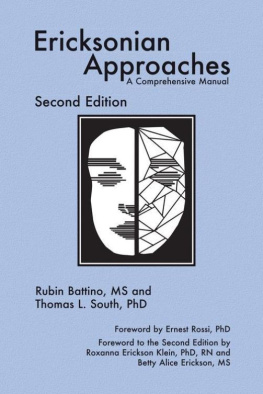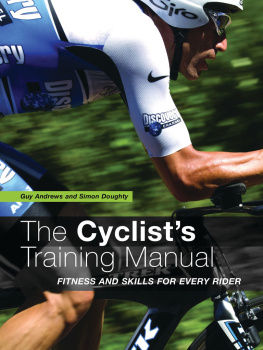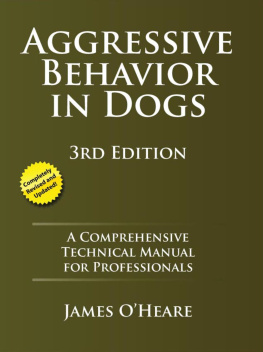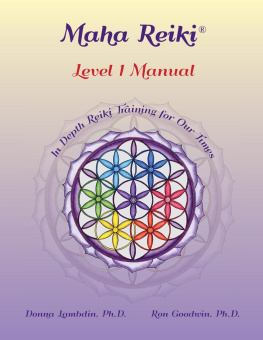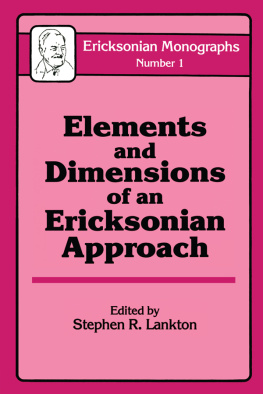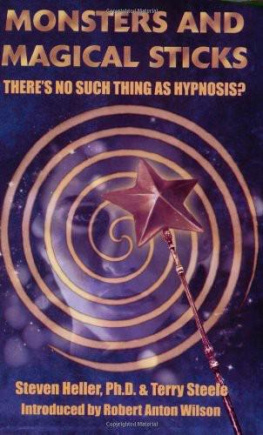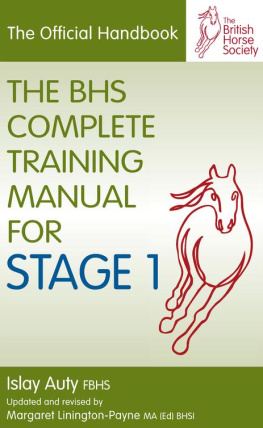Auld James - Ericksonian approaches: a comprehensive manual
Here you can read online Auld James - Ericksonian approaches: a comprehensive manual full text of the book (entire story) in english for free. Download pdf and epub, get meaning, cover and reviews about this ebook. City: Carmarthen;England, year: 2002;2010, publisher: Crown House Publishing, genre: Romance novel. Description of the work, (preface) as well as reviews are available. Best literature library LitArk.com created for fans of good reading and offers a wide selection of genres:
Romance novel
Science fiction
Adventure
Detective
Science
History
Home and family
Prose
Art
Politics
Computer
Non-fiction
Religion
Business
Children
Humor
Choose a favorite category and find really read worthwhile books. Enjoy immersion in the world of imagination, feel the emotions of the characters or learn something new for yourself, make an fascinating discovery.
- Book:Ericksonian approaches: a comprehensive manual
- Author:
- Publisher:Crown House Publishing
- Genre:
- Year:2002;2010
- City:Carmarthen;England
- Rating:3 / 5
- Favourites:Add to favourites
- Your mark:
- 60
- 1
- 2
- 3
- 4
- 5
Ericksonian approaches: a comprehensive manual: summary, description and annotation
We offer to read an annotation, description, summary or preface (depends on what the author of the book "Ericksonian approaches: a comprehensive manual" wrote himself). If you haven't found the necessary information about the book — write in the comments, we will try to find it.
Auld James: author's other books
Who wrote Ericksonian approaches: a comprehensive manual? Find out the surname, the name of the author of the book and a list of all author's works by series.
Ericksonian approaches: a comprehensive manual — read online for free the complete book (whole text) full work
Below is the text of the book, divided by pages. System saving the place of the last page read, allows you to conveniently read the book "Ericksonian approaches: a comprehensive manual" online for free, without having to search again every time where you left off. Put a bookmark, and you can go to the page where you finished reading at any time.
Font size:
Interval:
Bookmark:
Dedications
This work is dedicated to my
loving daughters, Marie and Melissa,
of whom I am so proud, as a continued
inspiration to their learning.
I also dedicate this work to
my loving wife, Barbara,
for her continued support
and understanding.
Tom
My contributions are dedicated
to my friends and mentors:
Howard H. Fink and
Joseph E. Emanuel,
and to my wife Charlotte.
Rubin
TLS is the founder of the Milton H. Erickson Society of Dayton, Ohio. After RB immersed himself in the work of Milton H. Erickson, he found out about the Society and joined it. We have each served as president of the Society for considerable periods and continue to be active. Our shared interests and our friendship resulted in our teaching a year-long training course in Ericksonian methods. This book is the outcome of that collaboration.
We were motivated to write the book because we have yet to come across materials that can be reasonably used for courses or for training. This is the case even though the literature on Ericksonian methods is extensive and expanding. The books in the field are wonderful resources, but do not seem to lend themselves to a systematic training program. This book is, of course, no substitute for reading Ericksons collected papers, the books he has written in collaboration with others, the monograph series on his work, or listening to and viewing his many presentations. But we hope it will prove to be useful as a text or a training manual. To that end, we have incorporated many exercises throughout the book. If you will examine the Table of Contents, you will note that we develop the subject in a systematic way. However, many of the chapters can stand alone if you are interested in a particular area. Our individual interests have had an effect on the content.
We were pleased to be joined in this endeavor by three experts in their respective fields who wrote specialty chapters for us. S. Sylvester has written on medical applications, J. Auld on dental applications, and L.S. Segal on substance abuse.
We would like to acknowledge the influence of the following people on our work: Milton H. Erickson, E.L. Rossi, J.K. Zeig, W.H. OHanlon, R. Pearson, K.F. Thompson, M.D. Yapko, S.G. Gilligan, S.R. and C.H. Lankton, D.B. Cheek, S. Rosen, H. Lustig, H.H. Fink, J.E. Emanuel, S. de Shazer, R. Bandler, and J. Grinder, among many others. This book could not have been produced without the assistance of the Word Processing Center of the Wright State University School of Medicine (Carol Enigk, director) and we owe an especial thanks to their staff. We also thank Michael Hall for assistance with the graphics and Alice McKinney and Charlotte Battino for advice on the layout of the book.
RB served as the overall coordinator and editor.
Thomas L. South, PhD
Dayton
Rubin Battino, MS
Yellow Springs
November, 1997
The original edition of this book was written by the two of us in 1994 with three specialty chapters by invited authors. After having that manuscript rejected about fifteen times by publishers, we decided to self-publish the book under the name of The Neurypnology Press. That edition sold very well. One of the buyers had a connection with Crown House Publishing Ltd in the UK and put us in touch with them. Crown House almost immediately offered us a contract, and our affiliation with them continues to be both cordial and mutually profitable. When our editor at Crown House suggested that we come out with a second edition, we agreed. In the ten years that have transpired since we wrote the original book there has been significant progress in research in hypnosis and hypnotherapy. Ericksonians continue to write books and papers, and the International Erickson Congresses are a source of new ideas and stimulation.
We adhere to our original concept of this book as a Comprehensive Manual on Ericksonian methods. That is, we consider this book to be a text for the kinds of training that most of the over one hundred institutes affiliated with the Milton H. Erickson Foundation carry out. We have been pleased to discover that many of those institutes use our book, and we are also pleased with this opportunity to bring it up to date. Having written that, we must also note that most of the basic training material in this book (like hypnotic language forms and basic inductions) have undergone little change. The sequence of topics is one that has apparently worked out well. Of course, new material has been introduced and referenced. The exercises throughout the book have been enhanced and refreshed.
The collaboration via contributed chapters by three experts in their respective fields has enhanced the book. J. Auld has revised his chapter. S. Sylvester has written on medical applications. Our dear friend, Leon S. Segal, died in August 2003. Segals chapter has been left intact.
Ernest L. Rossis contributions to the theory and practice of hypnosis have been considerable. A separate new chapter is devoted to presenting his contributions. Some modern research on brain function and hypnosis is included in this chapter.
TLS has added a new section, Emergency and Traumatic Situations, to Chapter 15, Utilization of Hypnosis, and revised and edited his other chapters.
RB has extended his chapters on metaphoric work and guided imagery based on his two books in those areas, and on new materials by other authors. We would also like to acknowledge the help that Professor Alan W. Scheflin has given us with respect to the materials in the chapter on ethics and the law.
We are pleased by the evolution of this book, and hope that you will be, too. We are always open to comments and suggestions.
RB continues to serve as the overall coordinator and editor of this book.
Thomas L. South, PhD
Huber Heights, Ohio
Rubin Battino, MS
Yellow Springs, Ohio
January, 2005
The developing maturity of a new school of professional psychotherapy is signaled by the appearance of Comprehensive Manuals that attempt to integrate the best inspirations of the pioneers with the growing body of fundamentals that are needed to teach another generation. This comprehensive manual by Thomas South, Rubin Battino, and their colleagues takes on this task with honesty and integrity. So broad has the scope of Milton H. Ericksons psychotherapy become in recent years that it is more and more difficult to discern Ericksons original voice. So many of his highly creative and individualistic students have carried Ericksons work in new unpredictable directions that there is now a real danger of losing the original threads of his genius.
This state of affairs would surely bring an impish smile to Milton Ericksons face. It is, after all, a true reflection of Ericksons view of at least one aspect of his own mission: to help others to find their own genius by teaching them in terms of the natural ways and metaphors of their own minds. This is one of the secret strengths of Ericksons original contributions that this comprehensive manual seeks to impart to the students and professionals. In one way or another it will be found to be a harmonic theme that connects the systematic presentation of the broad areas of Ericksons work with case studies, transcripts of inductions for different types of clients, and practical training exercises that can facilitate the students learning step by step.
But is all this really necessary, one might ask? Wasnt Milton Erickson an intuitive genius who could use his creative unconscious to simply free-associate incantations and hypnotic spells that would be just what the patient needed? You know, deep unconscious communication from the mind of one person to the other? Sort of healing without cognition? The symptoms somehow go away and nobody knows the reason why, not even the therapist. In spite of such folklore that has been spun about Ericksons work, this oversimplified appeal to the intuitive is certainly not correct. In his early years, Erickson worked very systematically to develop his understanding of the nature of hypnosiswhat he called the psycho-neuro-physiological foundations of healing. How can mere words, stories, meanings, and ideas facilitate healing?
Font size:
Interval:
Bookmark:
Similar books «Ericksonian approaches: a comprehensive manual»
Look at similar books to Ericksonian approaches: a comprehensive manual. We have selected literature similar in name and meaning in the hope of providing readers with more options to find new, interesting, not yet read works.
Discussion, reviews of the book Ericksonian approaches: a comprehensive manual and just readers' own opinions. Leave your comments, write what you think about the work, its meaning or the main characters. Specify what exactly you liked and what you didn't like, and why you think so.

